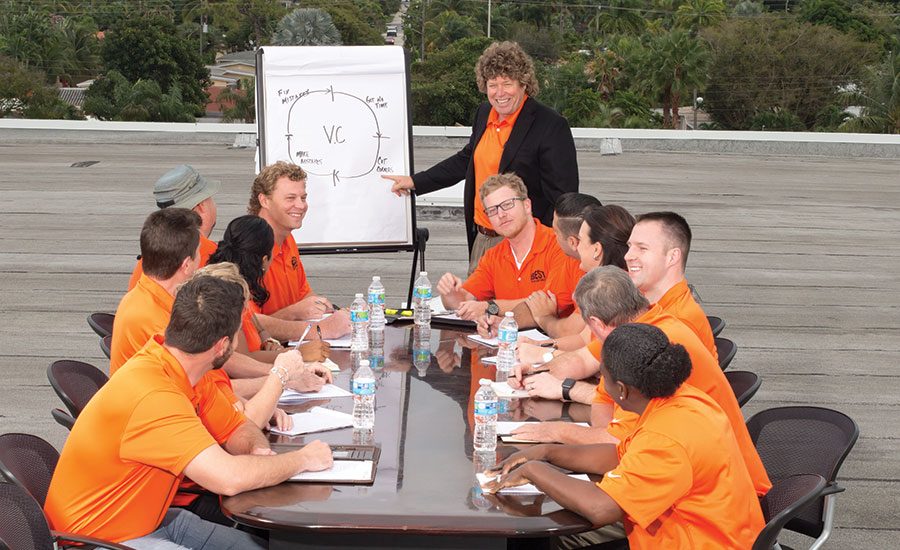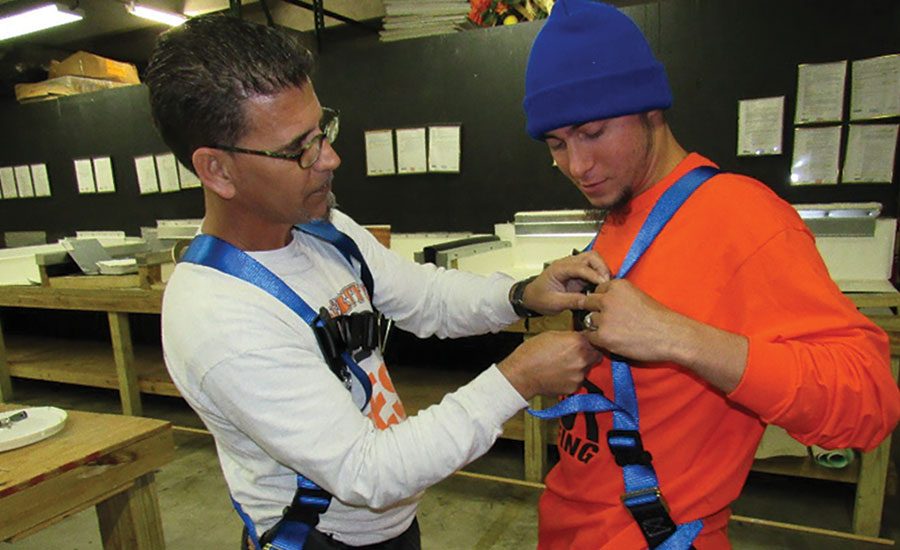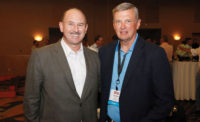After more than three decades of growing multiple roofing contractor businesses, Gregg Wallick is at an enviable stage in his career. Though he’s still working hard and nowhere near ready to turn the business over to his sons, the president and CEO of Best Roofing in Ft. Lauderdale, Fla., has the luxury of not having to focus on where the next job comes from. And he’s taking a long-term view of where his company and the roofing industry as a whole are going.
Wallick bought Best Roofing in 2001 after spending more than 20 years building the General Roofing Services group of companies. Except for a few tough years during the Great Recession, he has focused largely on growth based on his years of “hands-on” roofing experience. In addition to the Ft. Lauderdale headquarters, the company opened a branch office in Miami and has roughly 200 non-union employees focused heavily on roof replacement and service work (90 percent) versus new construction.
Wallick said the bulk of work is in commercial roofing (72 percent), although a large portion of that includes retirement villages, condos, and residential complexes that are prevalent in south Florida. Roof service accounts for roughly 22 percent of revenue, followed by traditional residential (6 percent).
And business is good. Since 2011, Best has consistently grown by an average of 20 percent each year, and was in the first 40 of RC’s 2015 Top 100 list with a reported $27 million in total revenue.
“We were able to hang on, but now that the work is back it’s allowed us to thrive. If you aren’t making it now, you’re not going to make it,” he said, noting that about 35 percent of Best’s competition closed in recent years.
Best was hardly immune to the recession. Backlog shrunk and the steady stream of new business dried up, forcing Wallick to shed overhead. At the lowest point, the staff dwindled to 55 people and the company had to get resourceful. Wallick focused on streamlining operations but also invested in prequalification sales training and software that improved the overall closing ratio by 25 percent.
The lessons stuck.
“We understand our pipeline of future opportunities and have figured out how to avoid the peaks and valleys that are so typical in this industry,” he said.
Creating a Culture
Wallick earned both a bachelor’s degree and master’s degree in business administration from the University of Miami – neither of which would have been possible without a football scholarship.
Once he got into business, the former team captain developed several strategies to create an atmosphere that illustrate how roofing is a team sport. Communication and mastering the fundamentals of one’s job are key, and were not prevalent in the company he took over in 2001. Within his first three years as owner, Wallick replaced every employee from the previous regime. He also re-engineered all of the departments and shifted focus from being a “bid and beg” contractor on new construction projects into a consultative roof replacement and service provider.
Now, every department has structured weekly meetings that start with discussions about the ‘fundamentals’ — an accumulated list of nearly two dozen guiding principles that Wallick staunchly believes helps employees provide the excellent service Best has built its strong reputation on.
“It’s important that everyone has a position to play in the delivery process of our goods and services,” he said.
Each quarter, every member of management has a formal review and quarterly bonuses are issued based on achievement. Around the same time, the entire company gathers for ‘The Huddle’ — part meeting, part pep rally — where employees are recognized for their accomplishments and get a preview of the next quarter’s projections and goals.
Little details matter too. All employees are expected to wear clean uniforms with shirts tucked in and hats worn straight. In addition to trucks used for equipment, Best also has a fleet of branded buses that the crews use to travel to and from jobsites together.
Once a year, the office staff cooks breakfast for the entire field staff as a formal ‘thank you’ in what’s called “The Breakfast of Champions.”
Much like a team locker-room, there’s a real sense of camaraderie, accountability and teamwork in the building that ultimately generates more business.
“Nobody is more important than anyone else,” he explained. “If everyone — from the person who takes the initial inquiry to the person collecting the payment — does their job and the client has an outstanding experience, we build solid relationships.”
Best also provides health insurance, 401K benefits, paid holidays and between seven and 21 days of personal time off, depending on years of service.
On the safety front, Best hosts weekly ‘tool-box talk’ meetings and conducts regular jobsite inspections. Inside headquarters are a hands-on training room and large classroom for ongoing instruction. Wallick said they also work with manufacturers and vendors on safety recommendations, and partner with the Florida Roofing and Sheet Metal Contractors Association (FRSA) for specific training.
Not Afraid of Fun, Failure
Another facet of Best’s internal culture is a willingness to try new and innovative approaches to attracting business, while separating the company from competitors in what can be a fierce market.
In addition to traditional marketing efforts, Best is known for distributing personalized emails with witty cartoons or inspiring messages to its vast contact list. A robust and dynamic website offers detailed information on the company’s history, culture and service offerings. Going above and beyond, the site also has interactive features like a client portal, a window for live chats and embedded links to their vibrant social media channels.
Part of that strategy emanates from Wallick’s entrepreneurial spirit that allows for innovation — and failure occasionally. Another part is added by his eldest son, Zack, who’s continued to enhance the business’ knack for reaching and engaging existing customers and prospects in new ways (see page 34). He officially joined the company in 2009 and worked his way up from a re-roof crew, to estimating, sales and now vice president.
One of the more popular branding tools Best has used successfully is devoting a lot of marketing collateral to Zack’s dog, Jake, a pure-bred boxer. He became the company mascot and has even been requested by clients at business meetings. There’s even a photo gallery dedicated to him as “director of stress reduction” on the website.
“I came to realize that he kind of humanizes us as a company and brings down some of the walls,” Zack explained. “We’re a much more relationship-based than transaction-based business and it helps us get to know the people we work with on projects.”
Zack recently earned his general contractor license and ultimately has a vision to diversify Best’s offerings further by building individual profit centers around its existing commercial business model. New service opportunities and adding doors and windows to product offerings are distinct possibilities.
Wallick’s younger son, Ian, is also in the fold in operations. He was recently tabbed with heading a new residential division that will focus on growing Best’s footprint in the single-family home market.
From estimating and installation to sales and marketing, Zack said he’s grateful to have literally learned the industry from the ground up standing beside his father. He’s also appreciative of the perspective he offers.
“He’s extremely successful and he’s earned everything he has in this business,” he said. “He’s really taken a backseat and guided me on how to successfully manage a team, and through his training and mentorship every day, he’s taught me how to fish (for my family).”
At this stage of the game, the elder Wallick wouldn’t have it any other way.
“My primary focus at this stage of my career in the roofing industry is developing the next generation of leaders,” he said. “I have the privilege of working with a number of very talented people. Understanding them and helping them achieve their objectives is what gets me excited these days.”







Report Abusive Comment